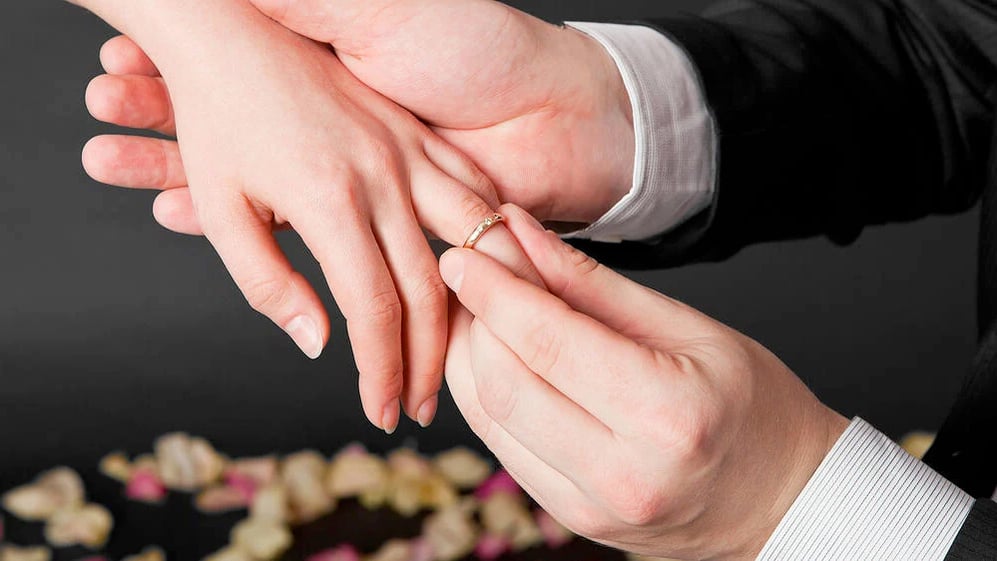This post is adapted from Commentary on Luther's Catechism: Confession and Christian Life by Ablrecht Peters.
The basic structure of the marriage rite in Wittenberg: marital discussion between the clans—betrothal—act of marriage—escorting [the bride] home, allows the ancient Germanic-German legal customs to shimmer through, even though reshaping took place during the Middle Ages. Originally, a marriage was concluded primarily in a discussion between the two clans. Such a “Mund- or clan marital agreement” was a “completed, legal transaction.” As part of this agreement, a corresponding Mund-dowry was determined and—at least in later times—a mostly symbolic deposit (arrha) would put the agreement in force, which made subsequent legal action possible. Such a “Mund-betrothal” (mahal—desponsatio [betrothal]) was completed in the “Mund-act of marriage” (prutigeba [giving of the bride]—traditio puellae [handing over the girl]). It would have taken place in some situation such as at a drinking party of the groom’s blood brothers; the bride was placed onto the lap of the suitor and his clan would have handed over the purchase price. The “Mund-betrothal” and “Mund-marriage” were the two stages of this unilateral transfer of guardianship; the two participating clans were the prime players.
Transitioning Thoughts with Marriage
From the eleventh and twelfth centuries on, the Church began to exercise increasing influence in what had originally been secular, legal customs. The terms “betrothal” and “marriage” achieved a clear, legal sense in the thirteenth century. The betrothal becomes an agreement between the two partners, the groom and the bride, in front of witnesses, which establishes the mutual relationship of trust. The guardian of the bride, of course, would give his assent. As a sign that it was no longer a one-sided confiscation, but rather a promise of mutual obligation to remain faithful, each of the partners would now place a ring on the hand of the other.
Analogously, the act of marriage itself took on a new role, so that handing over the bride into the guardianship of the husband and his clan now becomes a mutual giving of each of the partners to one another in the act of being joined in marriage (coniungere, copulare). When the actual act of marriage took place, the consensual discussion and the exchange of rings were both repeated.
The Divine Estate of Marriage
In great tension with the secular aspect, the theological thesis states that marriage is a “spiritual,” in fact a “divine estate,” not conceived by or instituted by human beings but instituted by God Himself, ordained and blessed by Him. This spiritual, inner dimension of marriage, however, is something that only a Christian person could recognize and at least begin to live out. For this reason, the congregation would have the duty to care for that institution and to make sure that its members entered into marriage in the presence of the triune God and wanted to live their life thereby. With respect to its responsibility, the Church has taken up this charge concerning its involvement in the act of marriage in a multitude of ways.
What The Marriage Booklet Dictates
According to Luther’s Marriage Booklet, the Church, or to be more specific, each particular local congregation that was under its parochial authority, was to participate in the overall marriage process of its members at three points: when it published the banns “from the pulpit,” at the act of marriage itself in front of the church door, and when the blessing was given, inside the church structure before the altar. These three actions have developed through a long, changeable history; even in the version in which they are presented in the Marriage Booklet, they give evidence of much of the interplay between the temporal and spiritual realms within the one Corpus Christianum. But of the essence, and this unfortunately is hardly ever recognized in the literature, such actions are carried out from within the spiritual realm of God, for they are carried out under the Word of God and prayer by the ordained person who serves in that spiritual realm.
Based on some observations offered by Luther, one could conclude that, with respect to all three stages, the Church was doing something alien to its purpose, as if the marriage was located within the free purview of the bridal couple and likewise under the legal control of the temporal authorities. But such a viewpoint is contradicted by the reference to the “blessing of God” and the “common, Christian prayer,” as the central office and work of the congregation and its pastor.
The first words of the document show that Luther starts out by referring primarily to the act of marriage itself; the actual location where the act of marriage takes place—whether in front of the church building or at the bridal house—points to its roots in that which is temporal and legal. But when he refers to the prayer and the blessing, Luther is thinking of the marriage blessing at the altar, which originally had connections with the Lord’s Supper. Because the two actions originate in different settings, each has a different level of importance for the community of Christ.
Officiating a Marriage
The pastor officiates at the act of marriage itself in an alien role, standing in for the clans or for the temporal authorities, “publicly before God and the world.” But the marriage blessing, by contrast, is what he carries out as the servant of the Christian community in his proper office under God’s Word and prayer.
In every conceivable way, the pastor is to share with the members of his congregation the trouble and danger, the suffering and cross that comes with the estate of matrimony, in order to stir them up and to coax them to seek God’s blessings and the prayers of the Christian Church. Whoever seeks to enter into his or her marriage without the blessing of God and seeks to live in marriage without prayer brings about a public act of a denial of God and is therefore to be placed under church discipline. The marriage blessing thus takes on the status of a command and has a different level of importance than the act of marriage itself that the pastor administers. And yet, the act of marriage in front of the door of the church, though primarily a worldly action, is not purely a secular action, since, as is true of the blessing inside the church structure, that action outside the building does not take place in the name of the clans or just because of some secular ordinance, but in the name of the triune God, the Creator, Redeemer, and Sanctifier.
In spite of all the interplay, with all the various accent points, the three actions in the Marriage Booklet achieve a unity by means of this name being used. Betrothal, the act of marriage, and the marriage blessing all occur in the name of the triune God as one and the same Lord of all three of the arch hierarchies: the family and household, the political, and the ecclesiastical.
To read more about marriage in relation to Luther's Marriage Booklet, order Peters' commentary below.















